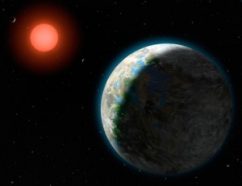Faraway planet could support life
A planet 20 light-years away could be the perfect distance from its star
Editor’s note: This story about the latest research on planet hunting demonstrates the scientific process at work. About a week after one group announced finding a potentially habitable planet, another group announced that it could not confirm the first group’s work (see the Science News story). So the researchers will keep testing the idea.
For years, planet-hunters have been searching for a planet other than Earth that can support life. They may have found one.
In other words: Aliens, if you’re out there, we’re getting closer.
The planet is the sixth found orbiting a star called Gliese 581. Steven Vogt, one of the scientists involved, told reporters that this star with its family of planets is “kind of a mini-version of our own solar system.” Vogt is an astronomer at the University of California, Santa Cruz.
He said he expects the new planet to have water. (On Earth, when we find water, we find life, so scientists looking for life on other planets look for water first.) “It’s pretty hard to imagine that water wouldn’t be there,” he said.

The new planet is 20 light years away, which is as far as 250 million trips to the Moon and back. We can’t travel at the speed of light — only light can go that fast — so even at the fastest speed we could manage, it would take a spaceship from Earth more than 200 years to go that far.
No, human beings won’t be visiting this planet any time soon.
But that doesn’t mean we can’t study it. Thanks to powerful new telescopes and new techniques for searching the skies, scientists can learn a lot about distant planets without ever leaving Earth.
Astronomers have found 492 exoplanets to date, which are also called extrasolar planets. The word “solar” refers to the sun, so an “extra-solar” planet is a planet that goes around a star other than the sun (the sun is also a star). These other stars are far away; in fact, Gliese 581 is a relatively close star, compared with many of the other stars found to have planets. Astronomers may be able to find new planets, but finding one that may have life is another story.
Remember Goldilocks and the Three Bears? Goldilocks had to find just the right porridge, just the right chair and just the right bed. Similarly, a planet that can support life has to be just the right size for its system and just the right distance from its star.
Some planets orbit so close to their stars that they’re much too hot for liquid water — or for life as we know it. Other planets keep their distance from the stars — where they’re too cold to have water or life.
But a right-sized planet that’s neither too close nor too far — which means it’s not too hot and it’s not too cold — might be just right for water. Astronomers even talk about the “Goldilocks Zone” of a planetary system. The Goldilocks Zone, also known as the “habitable zone,” is an orbit that’s just the right distance from a star for a planet to have the right conditions for life.
During a September 29 briefing for the press, the researchers described a planet that is probably just right. Called Gliese 581g, it is about three times as massive as Earth. It orbits its star so closely that it goes all the way around in only 37 days. Because it’s so close, it’s tidally locked, which means one side always faces its star, and the other side is always dark. Temperatures on Gliese 581g’s surface probably range between -24 degrees and 10 degrees Fahrenheit.
Maybe that doesn’t sound very Earthlike. After all, this planet is very close and very big. But its star, Gliese 581g, is a red dwarf, which means it’s much cooler than the sun. Because the star is much cooler, its close-in planets don’t get as hot.
Gliese 581g is an exciting discovery — and astronomers are likely to find more soon, thanks to new, powerful telescopes specifically designed to look for planets.
Paul Butler, a scientist at the Carnegie Institution for Science in Washington, D.C., worked on the study. He told reporters that astronomers will probably find more potential life-supporting planets soon: “Over the next 10 years I would be shocked if there weren’t many tens of these things.”







